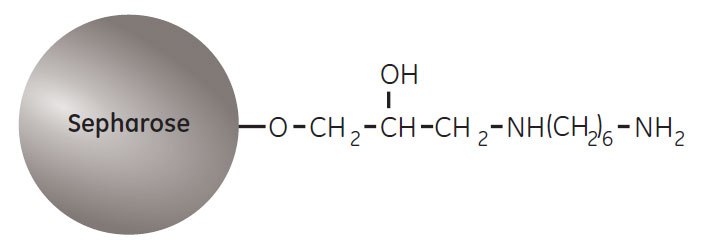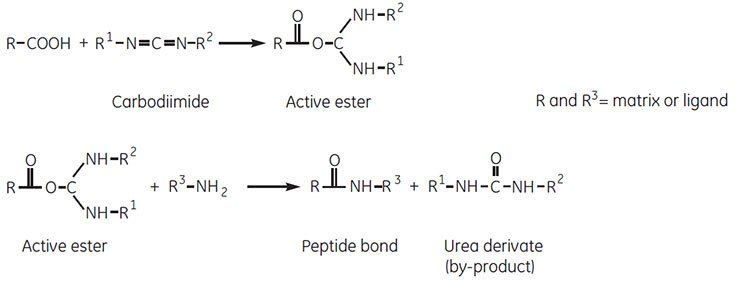Coupling Small Ligands Through Carboxyl Groups via a Spacer Arm
EAH Sepharose 4B
The partial structure of EAH Sepharose 4B is shown in Figure 4.10.

Figure 4.10.Partial structure of EAH Sepharose 4B.
Ligands are coupled in a simple one-step procedure in the presence of a coupling reagent, carbodiimide. The carbodiimides may be regarded as anhydrides of urea. The N,N’ di-substituted carbodiimides promote condensation between a free amino and a free carboxyl group to form a peptide link by acid-catalyzed removal of water. Thus EAH Sepharose 4B can be coupled with carboxyl-containing ligands. The carbodiimide yields an isourea upon hydration. The coupling reaction is shown in Figure 4.11.

Figure 4.11.Carbodiimide coupling reaction.
Chromatography medium characteristics
Characteristics of EAH Sepharose 4B chromatography medium are shown in Table 4.7.
1 Stability data refers to the coupled medium provided that the ligand can withstand the pH. Short term refers to the pH interval for regeneration, cleaning-in-place, and sanitization procedures. Long term refers to the pH interval over which the matrix is stable over a long period of time without adverse effects on its subsequent chromatographic performance.
Purification options
The purification options for EAH Sepharose 4B are shown in Table 4.8
1 See Appendix 4 to convert flow velocity (cm/h) to volumetric flow rate (mL/min). Maximum operating flow is calculated from measurement in a packed column with a bed height of 10 cm and i.d. of 5 cm.
Preparation of coupling reagent
Use a water-soluble carbodiimide such as N-ethyl-N’-(3-dimethylaminopropyl) carbodiimide hydrochloride (EDC) or N-cyclohexyl-N’-2-(4’-methyl-morpholinium) ethyl carbodiimide p-toluene sulfonate (CMC). These two carbodiimides have been used in a variety of experimental conditions and at a wide range of concentrations (Table 4.9). EDC often gives better coupling yields than CMC.
Use a concentration of carbodiimide greater than the stoichiometric concentration, usually 10- to 100-fold greater than the concentration of spacer groups.
The coupling reaction is normally performed in distilled water adjusted to pH 4.5 to 6.0 to promote the acid-catalyzed condensation reaction. Blocking agents are not usually required after the coupling reaction if excess ligand has been used.
Avoid the presence of amino, phosphate, or carboxyl groups as these will compete with the coupling reaction.
Preparation of EAH Sepharose 4B
Wash the required amount of matrix on a sintered glass filter (porosity G3) with distilled water adjusted to pH 4.5 with HCl, followed by 500 mM NaCl (80 mL in aliquots/mL sedimented matrix).
Ligand preparation
Dissolve the ligand and adjust to pH 4.5. The optimal concentration depends on the ligand. Organic solvents can be used to dissolve the ligand, if necessary. If using a mixture of organic solvent and water, adjust the pH of the water to pH 4.5 before mixing it with the organic solvent. Solvents such as dioxane (up to 50%), ethylene glycol (up to 50%), ethanol, methanol, and acetone have been used.
If organic solvents have been used, use pH paper to measure pH since solvents can damage pH electrodes.
Ligand coupling
- Add the ligand solution followed by the carbodiimide solution to the matrix suspension and leave on an end-over-end or similar mixer. Use a matrix: ligand solution ratio of 1:2 to produce a suspension that is suitable for coupling. Typically the reaction takes place overnight either at 4 °C or room temperature.
- Adjust the pH of the reaction mixture during the first hour (pH will decrease) by adding 100 mM sodium hydroxide.
- Wash at pH 8.0 and pH 4.0 to remove excess reagents and reaction by-products.
If a mixture of aqueous solution and organic solvent has been used, use this mixture to wash the final product as in Step 3. After Step 3 wash in distilled water, followed by the binding buffer to be used for the affinity purification.
Do not use magnetic stirrers as they can disrupt the Sepharose matrix.
Storage
Store preactivated matrices 4 °C to 8 °C in 20% ethanol.
Store the column in a solution that maintains the stability of the ligand and contains a bacteriostatic agent, see 20% ethanol in a suitable buffer.
The pH stability of the chromatography medium when coupled to a ligand will depend upon the stability of the ligand.
如要继续阅读,请登录或创建帐户。
暂无帐户?